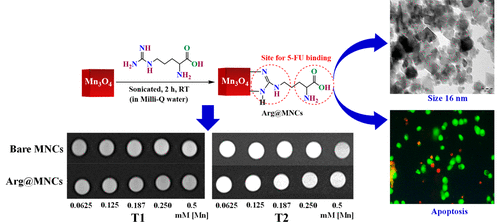当前位置:
X-MOL 学术
›
ACS Appl. Bio Mater.
›
论文详情
Our official English website, www.x-mol.net, welcomes your feedback! (Note: you will need to create a separate account there.)
Modulating the Delivery of 5-Fluorouracil to Human Colon Cancer Cells Using Multifunctional Arginine-Coated Manganese Oxide Nanocuboids with MRI Properties
ACS Applied Bio Materials ( IF 4.7 ) Pub Date : 2020-09-02 , DOI: 10.1021/acsabm.0c00780 Poonam Jain , Krunal Patel , Ashok Kumar Jangid , Anupam Guleria 1 , Sunita Patel , Deep Pooja 2 , Hitesh Kulhari
ACS Applied Bio Materials ( IF 4.7 ) Pub Date : 2020-09-02 , DOI: 10.1021/acsabm.0c00780 Poonam Jain , Krunal Patel , Ashok Kumar Jangid , Anupam Guleria 1 , Sunita Patel , Deep Pooja 2 , Hitesh Kulhari
Affiliation

|
5-Fluorouracil (5-FU) is one of the most prescribed drugs and the major component of chemotherapy for the treatment of colorectal cancer. In this study, we have designed arginine-functionalized manganese oxide nanocuboids (Arg@MNCs) for the effective delivery of 5-FU to colon cancer cells. Arginine was used as multifunctional agent to provide stability to MNCs, achieve high drug loading, control the release of loaded drug, and improve delivery to cancer cells. The synthesized Arg@MNCs were characterized by DLS, TEM, XRD, FTIR, XPS, TGA, and VSM analysis. The structural and morphological analysis by TEM showed cuboid-shaped MNCs with average particle size ∼15 nm. Biodegradation studies indicated that the Arg@MNCs were degraded at endolyosomal pH in 24 h while remaining stable at physiological pH. Hemolytic toxicity studies revealed the safety and nontoxic nature of the prepared MNCs. 5-FU-loaded Arg@MNCs showed significant control over the release of 5-FU, decrease in the hemolytic toxicity of loaded 5-FU but higher in vitro anticancer activity against HCT 116 and SW480 human colon cancer cells. Importantly, both the bare MNCs and Arg@MNCs showed excellent T1 and T2MR relaxivity under 3.0 T MRI scanner. Thus, the nanostructures developed in this study, i.e., 5-FU-Arg@MNCs could overcome the issues of both MNCs (stability) and 5-FU (low drug loading and nonspecificity) and may be used as a multifunctional theranostic nanocarrier for colon cancer treatment.
中文翻译:

使用具有 MRI 特性的多功能精氨酸涂层氧化锰纳米立方体调节 5-氟尿嘧啶向人类结肠癌细胞的传递
5-氟尿嘧啶 (5-FU) 是处方最多的药物之一,也是治疗结直肠癌的化学疗法的主要成分。在这项研究中,我们设计了精氨酸功能化的氧化锰纳米立方体 (Arg@MNCs),用于将 5-FU 有效递送至结肠癌细胞。精氨酸被用作多功能剂,为 MNCs 提供稳定性,实现高载药量,控制载药的释放,并改善对癌细胞的递送。通过 DLS、TEM、XRD、FTIR、XPS、TGA 和 VSM 分析对合成的 Arg@MNCs 进行了表征。TEM 的结构和形态分析显示平均粒径约为 15 nm 的长方体状 MNC。生物降解研究表明,Arg@MNCs 在 24 小时内在内溶体 pH 下降解,而在生理 pH 下保持稳定。溶血毒性研究揭示了制备的跨国公司的安全性和无毒性质。负载 5-FU 的 Arg@MNCs 显示出对 5-FU 释放的显着控制,负载 5-FU 的溶血毒性降低,但对 HCT 116 和 SW480 人结肠癌细胞的体外抗癌活性更高。重要的是,裸 MNCs 和 Arg@MNCs 在 3.0 T MRI 扫描仪下均显示出出色的 T1 和 T2MR 弛豫性。因此,本研究开发的纳米结构,即 5-FU-Arg@MNCs 可以克服 MNCs(稳定性)和 5-FU(低载药量和非特异性)的问题,可用作结肠的多功能治疗诊断纳米载体。癌症治疗。负载的 5-FU 的溶血毒性降低,但对 HCT 116 和 SW480 人结肠癌细胞的体外抗癌活性更高。重要的是,裸 MNCs 和 Arg@MNCs 在 3.0 T MRI 扫描仪下均显示出出色的 T1 和 T2MR 弛豫性。因此,本研究开发的纳米结构,即 5-FU-Arg@MNCs 可以克服 MNCs(稳定性)和 5-FU(低载药量和非特异性)的问题,可用作结肠的多功能治疗诊断纳米载体。癌症治疗。负载的 5-FU 的溶血毒性降低,但对 HCT 116 和 SW480 人结肠癌细胞的体外抗癌活性更高。重要的是,裸 MNCs 和 Arg@MNCs 在 3.0 T MRI 扫描仪下均显示出出色的 T1 和 T2MR 弛豫性。因此,本研究开发的纳米结构,即 5-FU-Arg@MNCs 可以克服 MNCs(稳定性)和 5-FU(低载药量和非特异性)的问题,可用作结肠的多功能治疗诊断纳米载体。癌症治疗。
更新日期:2020-09-02
中文翻译:

使用具有 MRI 特性的多功能精氨酸涂层氧化锰纳米立方体调节 5-氟尿嘧啶向人类结肠癌细胞的传递
5-氟尿嘧啶 (5-FU) 是处方最多的药物之一,也是治疗结直肠癌的化学疗法的主要成分。在这项研究中,我们设计了精氨酸功能化的氧化锰纳米立方体 (Arg@MNCs),用于将 5-FU 有效递送至结肠癌细胞。精氨酸被用作多功能剂,为 MNCs 提供稳定性,实现高载药量,控制载药的释放,并改善对癌细胞的递送。通过 DLS、TEM、XRD、FTIR、XPS、TGA 和 VSM 分析对合成的 Arg@MNCs 进行了表征。TEM 的结构和形态分析显示平均粒径约为 15 nm 的长方体状 MNC。生物降解研究表明,Arg@MNCs 在 24 小时内在内溶体 pH 下降解,而在生理 pH 下保持稳定。溶血毒性研究揭示了制备的跨国公司的安全性和无毒性质。负载 5-FU 的 Arg@MNCs 显示出对 5-FU 释放的显着控制,负载 5-FU 的溶血毒性降低,但对 HCT 116 和 SW480 人结肠癌细胞的体外抗癌活性更高。重要的是,裸 MNCs 和 Arg@MNCs 在 3.0 T MRI 扫描仪下均显示出出色的 T1 和 T2MR 弛豫性。因此,本研究开发的纳米结构,即 5-FU-Arg@MNCs 可以克服 MNCs(稳定性)和 5-FU(低载药量和非特异性)的问题,可用作结肠的多功能治疗诊断纳米载体。癌症治疗。负载的 5-FU 的溶血毒性降低,但对 HCT 116 和 SW480 人结肠癌细胞的体外抗癌活性更高。重要的是,裸 MNCs 和 Arg@MNCs 在 3.0 T MRI 扫描仪下均显示出出色的 T1 和 T2MR 弛豫性。因此,本研究开发的纳米结构,即 5-FU-Arg@MNCs 可以克服 MNCs(稳定性)和 5-FU(低载药量和非特异性)的问题,可用作结肠的多功能治疗诊断纳米载体。癌症治疗。负载的 5-FU 的溶血毒性降低,但对 HCT 116 和 SW480 人结肠癌细胞的体外抗癌活性更高。重要的是,裸 MNCs 和 Arg@MNCs 在 3.0 T MRI 扫描仪下均显示出出色的 T1 和 T2MR 弛豫性。因此,本研究开发的纳米结构,即 5-FU-Arg@MNCs 可以克服 MNCs(稳定性)和 5-FU(低载药量和非特异性)的问题,可用作结肠的多功能治疗诊断纳米载体。癌症治疗。



























 京公网安备 11010802027423号
京公网安备 11010802027423号